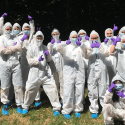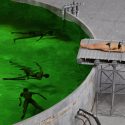A loud explosion wakes you up in the middle of the night. You look out the window and see a missile hit a building across the street. The neighborhood you grew up in, is now covered by fire and smoke. This might just seem like a terrible nightmare to you but this has become a reality for many citizens of Ukraine.
Today, we’ll tell their stories and show how they’ve come together to survive the unthinkable. The invasion of Ukraine began in February 2022 but this isn’t where the story starts. Since then, Russia has bombed residential areas and civilian infrastructure.
Russian president Vladimir Putin claims that Kyiv is controlled by American-sponsored neo-Nazis, and wishes to stop the Westernization of Ukraine as it continues its efforts to join NATO. Putin has said that he sees Ukraine and Russia as one. He also claims to be defending Russian speakers in Ukraine. He especially supports those in Donetsk and Luhansk, the self-declared republics that broke off from Ukraine in 2014.
Many Ukrainian civilians have joined the army, while others are trying to escape to safer cities or neighboring countries. Ukraine has fought back and launched counteroffensives, but there still has been a substantial loss of life and homes destroyed. How did a group of reporters survive a machine gun attack? How are newborn babies surviving the bombings? And how did the driver of this car survive?
Today we’ll count down the three most shocking stories that show what it takes to survive the horrors of war.
Number 3. Protecting the Future
As bombs started falling on Ukraine’s residential areas, hospital crews went into crisis mode. Some of the most delicate areas are NICU, or newborn intensive care unit wards. In Dnipro, in eastern Ukraine, staff had to move about a dozen newborn babies to the basement of the hospital. Nurses and doctors have to take turns holding and cradling the babies.
And some of them need to use manual ventilators to keep the newborns alive. Okhmatdyt is the largest children’s hospital in Kyiv. It was built in the 1970s by Soviet engineers, with underground bunkers designed to withstand Cold War battles. Now, these bunkers are filled with parents holding their children and the doctors caring for them.
Some of the kids need chemotherapy or heart surgery. Oncologists are doing whatever they can to keep their patients alive. This includes taking plasma from parents for blood transfusions. These brave doctors and nurses try their best to keep the kids’ spirits up by playing with them and singing songs. The goal is to evacuate and send children to another hospital in Western Ukraine and eventually to Poland. This is still dangerous. And it will take time.
Number 2. Media Ambush
British Chief correspondent Stuart Ramsay and his Sky News team were in a vehicle trying to get to Kyiv. After getting directions from a police officer, they got to a quiet intersection. A little too quiet. Suddenly they felt something hit the car and a tire burst. The attack had begun.
More bullets kept hitting the car, cracking the windshield as the team ducked and huddled inside the vehicle. The crew scrambled from the car one by one, sprinting and jumping over a railing and down into an embankment. Camera operator Richie Mockler was shot twice but was saved by his body armor, and he never stopped recording. Next, they ran to a warehouse where a group of Ukrainian mechanics kept them safe until they were rescued. All survived.
When reporting from a war zone, it’s imperative to wear protection like body armor and a helmet. Try to keep it covert, so you don’t look like a soldier or police officer. And if you’re ambushed in your car, take cover but act fast since the car won’t protect you for long. Try your best to climb to the door closest to a ditch or a building. When you get out of the car, stay as close to the ground as possible. This makes it harder for a shooter to hit you.
Number 1. Miracle on the Road
Since the first days of the Russian invasion, the streets of Kyiv have been in total chaos. The world was shocked to see footage and photos of Russian tanks circling Ukraine. One of the videos that went viral was especially disturbing. Here you see a solitary car being driven over by a fast-moving tank, both forwards and then in reverse. The person recording screams in horror.
But relief would come shortly after, as shown in a viral video when a crowd surrounded the vehicle. Surprisingly, the 53-year-old man who was driving the car was alive and conscious. Bystanders then used crowbars to set him free from the twisted metal around him. The man’s left arm and leg were broken. The fact that the tank hit the car head-on might have been the key to his survival.
If it had hit the side of the car before driving over it, the tracks would have been directly crushing the seats. But everything happened so fast that reacting was almost impossible. Chalk this one up to luck. There’s a common denominator to our three stories. A helping hand, or hands, when you need it the most.
Whether it is medical professionals assisting newborns to breathe, a mechanic giving shelter to reporters or bystanders freeing an injured man from his car. The care that Ukrainians are showing is resulting in survival. This invasion has directly affected more than 12 million people and displaced over 6 million from their homes. Ukrainians need all the help they can get right now, and you can save lives today by clicking the link in the description.
Sources
- “Sky News Team’s Harrowing Account Of Their Violent Ambush In Ukraine This Week“. 2022. Sky News.
- “Time Running Out For Sick Ukrainian Kids Sheltering In Hospital Bunkers – National | Globalnews.Ca“. 2022. Global News.
- “What Common Or Household Objects Will Stop Bullets?“. 2021. The Prepared.
- “Viral Video Shows Elderly Ukrainian Man Miraculously Survived After The Car He Was Driving Was Run Over By A Russian Armored Vehicle ‘For Fun‘”. 2022. Business Insider.
- “What’S The Weight Of A Military Tank? The 10 Heaviest Tanks In The World“. 2020. Weight Of Stuff.

















